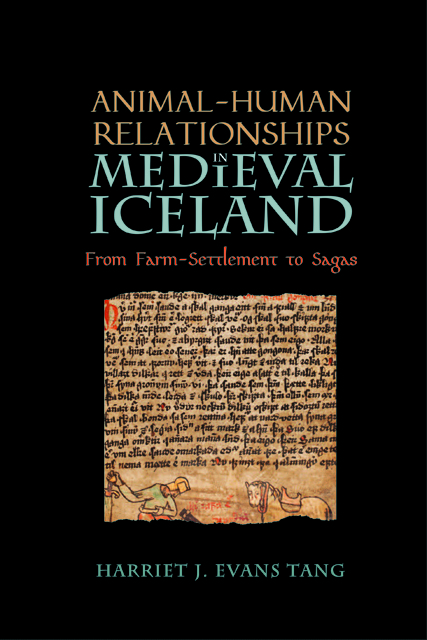Book contents
- Frontmatter
- Dedication
- Contents
- List of Illustrations
- Acknowledgements
- Note on Translations
- The Animal Acts …
- 1. An Animal-Human Settlement
- 2. Home, Sweet Home: Meeting Points on the Animal-Human Farm
- 3. The Animal-Human Community: Legal Tradition in Iceland
- 4. Fostering Relations: The Animal-Human Home in the Íslendingasögur
- 5. The Negative Animal: Absence, Precarity, and Danger
- … And the Man Responds
- Bibliography
- Index
- Nature and Environment in the Middle Ages
4. - Fostering Relations: The Animal-Human Home in the Íslendingasögur
Published online by Cambridge University Press: 11 January 2023
- Frontmatter
- Dedication
- Contents
- List of Illustrations
- Acknowledgements
- Note on Translations
- The Animal Acts …
- 1. An Animal-Human Settlement
- 2. Home, Sweet Home: Meeting Points on the Animal-Human Farm
- 3. The Animal-Human Community: Legal Tradition in Iceland
- 4. Fostering Relations: The Animal-Human Home in the Íslendingasögur
- 5. The Negative Animal: Absence, Precarity, and Danger
- … And the Man Responds
- Bibliography
- Index
- Nature and Environment in the Middle Ages
Summary
The importance of domestic animals in both the material and narrative settlement of Iceland, and in the way in which the Icelandic home-place physically and legally developed, is interwoven into the stories that medieval Icelanders told about their past. However, it should not be assumed that the functional importance or affectionate esteem of domestic animals automatically set them up for inclusion in these stories. The attachment of animals and animal-human interactions to these texts was dependent on their usefulness to the narrative of the saga; yet their very nature of being useful to the narrative tells us something rather poignant about the animal-human relationships rooted in these tales. Domestic animals, as co-creators of the Icelandic community, were entangled with their human partners not just as objects for consumption but in affective relationships.
It has been previously argued that an interdisciplinary approach is necessary to fully understand medieval Icelandic texts, although the breadth of such an interdisciplinary approach has only recently been extended to include archaeology. Reading animal-human relations in the sagas with a perspective enhanced by the examination of settlement narratives, spatial-functional analyses of farm sites, and the exploration of legal definitions and classifications undertaken in the preceding chapters, enables deeper understandings of these narratives to be formed in relation to the world in which they were produced and which they wished to emulate. This chapter will analyse three examples of animals in the Íslendingasögur who show recognition of the human home-farm, and whose interactions with these places form a component of their relationship(s) with human figures. It will take this discussion onwards to the figure of Grettir Ásmundarson, who is notoriously without a place to belong throughout much of his saga but for whom animals seem to become a way through which his character is developed. Grettir’s final place to belong is an island of sheep, on which he forms a multispecies flock of individuals, brought together by the need to be somewhere close to other animals.
Animals at Home in the Íslendingasögur
The Íslendingasögur present many examples of animal interaction with and within the farm and homefield, and the humans interacting within these spaces.
- Type
- Chapter
- Information
- Animal-Human Relationships in Medieval IcelandFrom Farm-Settlement to Sagas, pp. 140 - 183Publisher: Boydell & BrewerPrint publication year: 2022



